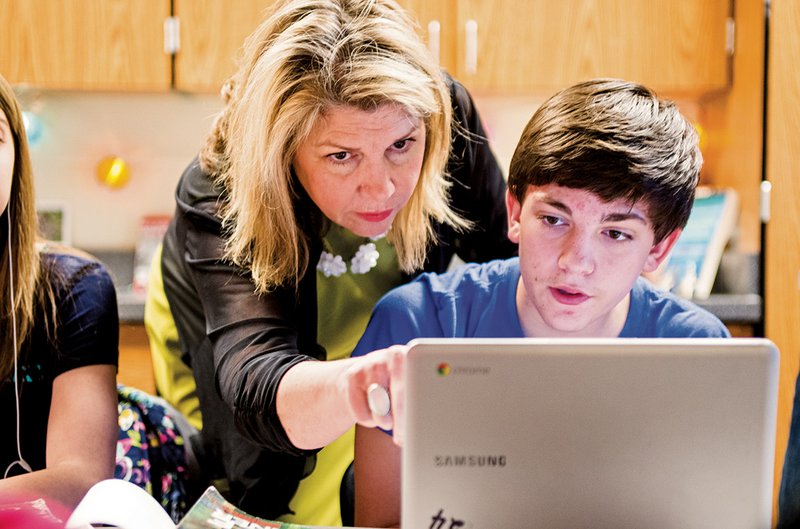When learning about the seasons, first-graders at Northside Elementary School in Cabot talk about flowers, trees, cookouts and playing outside. But within that lesson, they are taught more than which season comes after winter.
Julie Mahoney sat in a computer lab Friday morning, a class of first-grade students seated quietly at her feet. The screen behind her was on, and she had a wireless keyboard in her hands. Mahoney was preparing the students to use the educational computer program Wixie, an online tool using text and images to help students illustrate and communicate lessons, to show why they like spring.
“I want to make a title so people know what this is about,” she told the class, a virtual blank canvas projected behind her. “How do I add text?”
Several hands shot up in the air.
“Start a text box! Click on the big T!” the students instructed. “Double-click in the box!”
The class continued for a few more minutes with students suggesting images that signify spring — flowers, trees and bouquets — and writing sentences about the season while telling Mahoney when to use uppercase letters and punctuation.
“Make sure you hit shift to make it uppercase,” one student said. “But not caps lock, or the rest of them will be big.”
Once the Wixie project example was complete, Mahoney instructed the students to go to their own computers. It was their turn to talk about spring — and practice their computer techniques.
On another campus within the district, junior high students were using Chromebooks — small, Google Cloud based laptops — to compare Lord of the Flies and The Maze Runner, two books they had read in class.
Cabot Junior High School North English teacher Deana Davis gave instructions and answered questions as her students worked in Movenote, an app that helps users make video presentations that integrate video recordings and visuals, to prepare their thoughts on the two books.
Once those projects were complete, Davis said, the students could use Chromecast to project and share their videos with the class.
“We like Chromecast for presentations because it is so quick,” she said. “It’s a lot of collaborative learning.”
B.J. Brooks, director of instructional technology for the Cabot Public Schools, said the district is using different forms of technology to supplement learning in kindergarten through the 12th grade.
For the youngest students in Cabot schools, technology use started out with weekly trips to the computer lab for educational games.
“We have decided that wasn’t good enough,” Brooks said.
Now the students learn how to use the computer, integrating proper use of grammar and punctuation with the practical side of how to make a letter uppercase on the computer and what to press to get a question mark.
Second-graders are manipulating images, referring to them by their technical names such as JPEG and BMP instead of calling them pictures, Brooks said. By fifth and sixth grades, students are writing binary code.
In March 2013, the school district purchased 60 Chromebooks to use in classrooms. Davis’ junior high classroom was chosen to keep one of the class sets at all times, and the others were distributed throughout the district.
Brooks said she met with the curriculum team to determine which teacher would get full-time use of the Chromebooks. Math and science classes usually get new technology, so team members wanted to branch out and put the Chromebooks in a literature class — one with an already exceptional teacher who might not have a technology background — to determine how easy or hard it was to integrate the technology into literature lessons.
Since then, the district has acquired a total of 1,253 Chromebooks, with four sets stationed permanently in specific classrooms and the rest in mobile labs. Brooks said the Chromebooks have been well-received among teachers of all grade levels.
Tammy Tucker, assistant superintendent for curriculum and instruction, said the technology devices are tools that have enhanced learning, but they have not taken the place of well-trained and talented instructors.
“I do not want to diminish the importance of an effective teacher,” she said. “These are devices to help those teachers do what they already do.”
Additionally, working with different devices prepares students for a variety of scenarios they could step into after graduation.
“Our goal is for the technology to become so transparent that it becomes like a pencil,” Brooks said. “Students don’t need to be instructed on how to use a pencil. They just know how to use it to get the work done. That’s how we want technology to be.”
Technology Director Kendel Wells said the district has a “hybrid network” with a variety of devices such as Chromebooks, Apple computers and tablets, and Windows personal computers.
“We want our students to be comfortable stepping into any setting,” Tucker said.
Wells said the district has tried to be forward-thinking when it comes to building a technology infrastructure that can handle the demands that will grow as more devices are introduced to the classroom, such as increased bandwidth and Wi-Fi.
“Some of those things have to happen ahead of time,” he said.
As far as security is concerned, there are filters in place to make sure students stay out of websites they do not have permission to visit. The district also uses Google SafeSearch and makes sure superfluous content — such as ads, comments and “Related Videos” on YouTube — are not visible.
Wells said he expects the district’s technology arsenal to grow, reaching a total of 2,000 Chromebooks by August, for example. When it comes to infrastructure, applications and hardware, it is important for faculty, teachers and students to work together.
“The technology is changing so fast,” he said. “We have to collaborate. We have to share information.”
Staff writer Angela Spencer can be reached at (501) 244-4307 or aspencer@arkansasonline.com.
